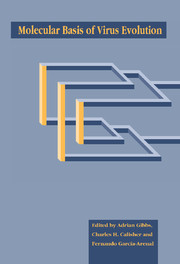Book contents
- Frontmatter
- Contents
- List of contributors
- Editors' preface
- Conference participants
- 1 Introduction and guide
- Part I The impact of viral diseases
- Part II Origins of viruses and their genes
- Part III Sources of virus variation
- Part IV Molecular interactions of viruses and their hosts
- Part V Viruses, hosts and populations
- Part VI Case studies of viral taxa; their systematics and evolution
- 18 Evolution of poxviruses and African swine fever virus
- 19 Molecular systematics of the flaviviruses and their relatives
- 20 Herpesviridae
- 21 Aphthovirus evolution
- 22 Evolution of the Bunyaviridae
- 23 Evolution of the tobamoviruses
- 24 The luteovirus supergroup: rampant recombination and persistent partnerships
- 25 The evolution of the Reoviridae
- 26 Genetic variation and evolution of satellite viruses and satellite RNAs
- 27 Molecular evolution of the retroid family
- 28 Adaptation of members of the Orthomyxoviridae family to transmission by ticks Patricia
- 29 The Order Mononegavirales: evolutionary relationships and mechanisms of variation
- 30 The molecular evolution of the human immunodeficiency viruses
- 31 Molecular evolution of papillomaviruses
- 32 Molecular systematics of the Potyviridae, the largest plant virus family
- 33 Evolution of alphaviruses
- 34 Evolution of influenza viruses: rapid evolution and stasis
- Part VII Techniques for viral systematics
- Index
30 - The molecular evolution of the human immunodeficiency viruses
Published online by Cambridge University Press: 04 May 2010
- Frontmatter
- Contents
- List of contributors
- Editors' preface
- Conference participants
- 1 Introduction and guide
- Part I The impact of viral diseases
- Part II Origins of viruses and their genes
- Part III Sources of virus variation
- Part IV Molecular interactions of viruses and their hosts
- Part V Viruses, hosts and populations
- Part VI Case studies of viral taxa; their systematics and evolution
- 18 Evolution of poxviruses and African swine fever virus
- 19 Molecular systematics of the flaviviruses and their relatives
- 20 Herpesviridae
- 21 Aphthovirus evolution
- 22 Evolution of the Bunyaviridae
- 23 Evolution of the tobamoviruses
- 24 The luteovirus supergroup: rampant recombination and persistent partnerships
- 25 The evolution of the Reoviridae
- 26 Genetic variation and evolution of satellite viruses and satellite RNAs
- 27 Molecular evolution of the retroid family
- 28 Adaptation of members of the Orthomyxoviridae family to transmission by ticks Patricia
- 29 The Order Mononegavirales: evolutionary relationships and mechanisms of variation
- 30 The molecular evolution of the human immunodeficiency viruses
- 31 Molecular evolution of papillomaviruses
- 32 Molecular systematics of the Potyviridae, the largest plant virus family
- 33 Evolution of alphaviruses
- 34 Evolution of influenza viruses: rapid evolution and stasis
- Part VII Techniques for viral systematics
- Index
Summary
Introduction
Two major groups of immunodeficiency-associated retro viruses are presently known to infect man. These are human immunodeficiency virus type 1 (HIV-1) which is the recognized agent of AIDS in Central Africa, Europe, the United States, and most countries worldwide (Barre-Sinoussi et ai, 1983; Popovic et aL, 1984), and the more geographically restricted human immunodeficiency virus type 2 (HIV-2), which is most predominant in West Africa (Barin et ai, 1985; Clavel et al., 1987). Although a causative relationship between HIV-1, HIV-2 and clinical AIDS is well established (Fauci, 1988), the pathogenic mechanisms by which these viruses induce immunosuppression and disease remain unknown. Ten million individuals are currently infected with HIV worldwide and this number is expected to rise to 40 million by the year 2000 (Mann, 1992). Given the magnitude of the AIDS pandemic, new insights into the natural history of HIV-1 and HIV-2 infection as well as a better understanding of the events responsible for their recent epidemic spread are critically needed for a rational drug design and the development of effective vaccines.
Molecular characterization of HIV-1 and HIV-2, including cloning and sequence analysis of several full-length genomes, has revealed features that distinguish human AIDS viruses from the traditional RNA tumour viruses. First, the HIV-1 and HIV-2 genomes are relatively complex, each including at least six genes (in addition to the common gag, pol and env genes) termed vif, vpr, vpu (HIV-1 only), vpx (HIV-2 only), tat, rev and nef, which collectively regulate viral transcription, translation, latency and other properties that contribute to viral pathogenesis (Cullen, 1991).
- Type
- Chapter
- Information
- Molecular Basis of Virus Evolution , pp. 438 - 454Publisher: Cambridge University PressPrint publication year: 1995
- 1
- Cited by



